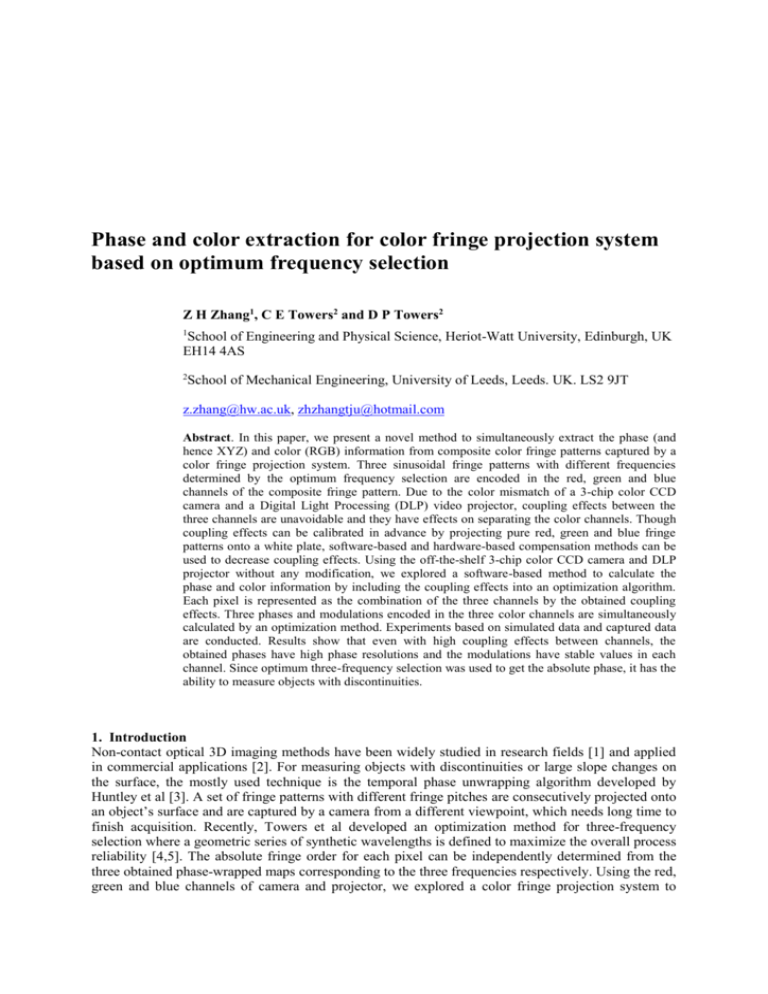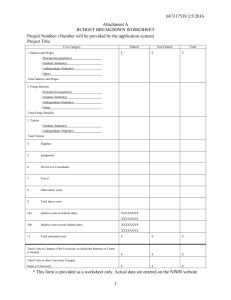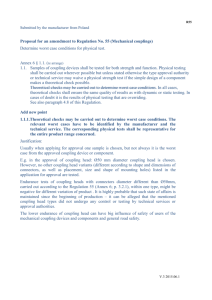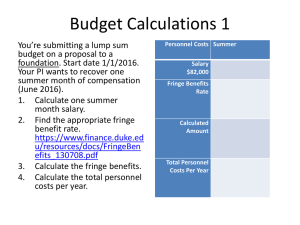Phase and colour extraction for colour fringe projection system
advertisement

Phase and color extraction for color fringe projection system based on optimum frequency selection Z H Zhang1, C E Towers2 and D P Towers2 1 School of Engineering and Physical Science, Heriot-Watt University, Edinburgh, UK EH14 4AS 2 School of Mechanical Engineering, University of Leeds, Leeds. UK. LS2 9JT z.zhang@hw.ac.uk, zhzhangtju@hotmail.com Abstract. In this paper, we present a novel method to simultaneously extract the phase (and hence XYZ) and color (RGB) information from composite color fringe patterns captured by a color fringe projection system. Three sinusoidal fringe patterns with different frequencies determined by the optimum frequency selection are encoded in the red, green and blue channels of the composite fringe pattern. Due to the color mismatch of a 3-chip color CCD camera and a Digital Light Processing (DLP) video projector, coupling effects between the three channels are unavoidable and they have effects on separating the color channels. Though coupling effects can be calibrated in advance by projecting pure red, green and blue fringe patterns onto a white plate, software-based and hardware-based compensation methods can be used to decrease coupling effects. Using the off-the-shelf 3-chip color CCD camera and DLP projector without any modification, we explored a software-based method to calculate the phase and color information by including the coupling effects into an optimization algorithm. Each pixel is represented as the combination of the three channels by the obtained coupling effects. Three phases and modulations encoded in the three color channels are simultaneously calculated by an optimization method. Experiments based on simulated data and captured data are conducted. Results show that even with high coupling effects between channels, the obtained phases have high phase resolutions and the modulations have stable values in each channel. Since optimum three-frequency selection was used to get the absolute phase, it has the ability to measure objects with discontinuities. 1. Introduction Non-contact optical 3D imaging methods have been widely studied in research fields [1] and applied in commercial applications [2]. For measuring objects with discontinuities or large slope changes on the surface, the mostly used technique is the temporal phase unwrapping algorithm developed by Huntley et al [3]. A set of fringe patterns with different fringe pitches are consecutively projected onto an object’s surface and are captured by a camera from a different viewpoint, which needs long time to finish acquisition. Recently, Towers et al developed an optimization method for three-frequency selection where a geometric series of synthetic wavelengths is defined to maximize the overall process reliability [4,5]. The absolute fringe order for each pixel can be independently determined from the three obtained phase-wrapped maps corresponding to the three frequencies respectively. Using the red, green and blue channels of camera and projector, we explored a color fringe projection system to modulate the three fringe patterns into the three color channels to reduce the capturing time further [6]: one image for the Fourier transform and four images for the four-frame phase shifting algorithm. For the most color CCD cameras and digital light processing (DLP) video projectors, the spectra of the three channels are designed to overlap so that there is no color-blind area, which means coupling effects between channels are unavoidable. Due to coupling effects, calculating the phase by directly separating the three channels has large noise, as reported in [6]. Software-based and hardware-based compensation methods can be used to decrease coupling effects [7]. Using the off-the-shelf 3-chip color CCD camera and DLP projector without any modification, we will explore a software-based method to simultaneously extract the phase and color information from the composite color fringe patterns. When the parameters of a camera and a projector are unchangeable, the system’s coupling effects can be calibrated by projecting pure primary color (red, green and blue) fringe pattern onto a white board [6]. Each pixel of the captured image is represented as the combination of the three color channels by the obtained coupling effects. Three phases and modulations encoded in the three color channels are simultaneously calculated by an optimization method. Therefore, not only shape but also color of a captured object can be obtained from the composite color fringe patterns. 2. Principle When three fringe patterns with different pitches are simultaneously projected from the red, green and blue channels of a DLP projector and the composite RGB fringe patterns are captured by a 3-chip color CCD camera, one pixel I i in a chosen channel i containing coupling effect ki , j can be represented as I i x, y I i, dc x, y I i, m x, y cosi x, y i ki, j I j , dc x, y I j , m x, y cos j x, y j I i, D x, y , (1) i, j R, G, B, but j i where I i , dc and I i , m are the average intensity and intensity modulation, respectively; i is the phase corresponding to the object height; i is the phase shift; ki , j is coupling effect calibrated beforehand [6] and I j , dc , I j , m , j , j have the same meanings as the corresponding parts in the chosen channel i. I i , D is the background intensity from the dark current of the camera for the chosen channel. x and y are the indexes of one pixel and in the following we will omit them for brevity. represents the crosstalk coming from the other two channels. For four-frame phase shifting algorithm, i , j 0, / 2, ,3 / 2 , the corresponding phase-shifted fringe patterns in the red, green and blue channels can be represented as I r ,n I r ,dc I r ,m cosr n / 2 k g ,r I g ,dc I g ,m cosg n / 2 kb,r I b,dc I b,m cosb n / 2 I r ,D , (2) I g ,n I g ,dc I g ,m cos g n / 2 kr ,g I r ,dc I r ,m cosr n / 2 kb,g I b,dc I b,m cosb n / 2 I g ,D , (3) I b,n I b,dc I b,m cosb n / 2 kr ,b I r ,dc I r ,m cosr n / 2 k g ,b I g ,dc I g ,m cos g n / 2 I b,D , (4) where n 0,1,2,3 . In fact, equations (2)-(4) contain twelve equations altogether. Combining the twelve equations gets the following equations I r 0 I r180 2 I r ,m cosr 2k g ,r I g ,m cos g kb,r I b,m cosb I r 270 I r 90 2 I r ,m sin r 2k g ,r I g ,m sin g kb,r I b,m sin b I g 0 I g180 2 I g ,m cos g 2k r , g I r ,m cosr kb, g I b,m cosb . (5) I g 270 I g 90 2 I g ,m sin g 2k r , g I r ,m sin r kb, g I b,m sin b I b 0 I b180 2 I b,m cosb 2k r ,b I r ,m cosr k g ,b I g ,m cos g I b 270 I b90 2 I b,m sin b 2k r ,b I r ,m sin r k g ,b I g ,m sin g There are six unknown variables, I r , m , I g , m , I b, m , r , g , b , in equation (5), so solving these equations can simultaneously get the phase and intensity modulation in the three channels. A nonlinear optimisation subroutine called lsqnonlin in Matlab 7 is used to calculate the unknown variables. Applying this algorithm to all the pixels estimates phase and modulation information in the three color channels together. 3. Experiments and results 3.1. Simulation First we evaluated this algorithm using the simulated data. Because the optimized three-frequency selection method is used in our color fringe projection system [6], the synthetic composite fringe patterns have 90, 99 and 100 fringes in the red, green and blue channels, respectively. The average intensity and intensity modulation for all channels are 100 and 60. In order to test the robustness to the noise, we added 3.5% Gaussian noise to the generated fringe patterns. Twenty-five RGB fringe patterns with coupling effects of 1, 2, …, 25 % were synthesized by software in a computer. To simplify the evaluation without losing its generality, we just consider a 1-D case along the x axis including all fringe patterns. One synthetic composite RGB fringe pattern with 20% coupling effect is shown in Figure 1. Using the proposed algorithm, we calculated phase and modulation in each channel and then evaluated the performance by using resolution for phase and standard deviation for modulation, as shown in Figure 2(a) and (b). In comparison, we also calculated phase resolution and standard deviation of modulation by using the standard four-frame phase shifting algorithm [8], as shown in Figure 2(c) and (d). We can see coupling effect has no effect on calculating phase and modulation by using our proposed algorithm. The standard phase shifting algorithm becomes much worse for calculating phase and modulation when coupling effect increases. (a) (a) 150 200 250 300 350 400 450 500 (b) 250 200 150 100 50 150 Modulation std 100 Phase resolution 50 (b) 4 250 200 150 100 50 100 50 5 10 15 20 3.5 3 2.5 2 25 5 10 (c) 15 20 25 15 20 25 (d) 100 150 200 250 300 350 400 450 500 (c) 250 200 150 100 50 50 100 150 200 250 300 350 400 450 500 Figure 1 Synthetic composite RGB fringe pattern with 20% coupling effect and 3.5% Gaussian noise. The fringe number in R, G and B is 90, 99 and 100, respectively. (a) red channel; (b) green channel and (c) blue channel. 150 Modulation std 50 Phase resolution 14 100 50 5 10 15 20 25 12 10 8 6 4 2 5 10 Figure 2 Phase resolution and modulation standard deviation with different coupling effects. The solid, dashed and dotted line corresponds to the red, green and blue channels, respectively. 3.2. Experiment We conducted the experiments on the actual composite RGB fringe pattern on a white plane board captured by our color fringe projection system [6]. Such four composite fringe patterns with π/2 phase shift consecutively in each channel were generated in a computer and sent out onto the white board by a DLP projector. A 3-chip color CCD camera captured these deformed color fringe patterns from another viewpoint. For different color cameras and DLP projectors, and even for the same camera and projector with different parameters, coupling effects between channels are different. We calibrated our system to obtain coupling effect. Applying the proposed algorithm to each pixel calculated the wrapped phase and modulation. Figure 3 shows one composite RGB fringe pattern and the obtained phase in the three channels. Table 1 gives the phase resolution by using our proposed algorithm and the standard phase shifting algorithm. In order to quantitatively display the modulation, we averaged all these rows to get a profile, as illustrated by the solid line in Figure 4. In the meanwhile, we calculated the modulation by the standard method in [8], as illustrated by the dash line in Figure 4. In actual situations, due to the influences of the number of fringes, the intensity values and the uneven intensity in the captured image, coupling effect in each channel is not a constant. Therefore, the acquired modulations have unstable values in the three channels. Table 1 shows the standard deviation of modulation for the three channels by the two algorithms. Our proposed algorithm gives a much better result in the red channel, a little better in the green channel, while the blue channel is a little worse than the standard phase shifting and modulation calculation algorithm. We believe this comes from the assumed unchangeable coupling effect used in our algorithm. (a) (b) (c) Figure 3 Phase calculated by the proposed algorithm. (a) is one composite RGB fringe pattern captured by our color projection system; (b), (c) and (d) are phase in the red, green and blue channels, respectively. (d) (a) 100 80 60 100 200 300 400 500 600 700 800 900 1000 600 700 800 900 1000 600 700 800 900 1000 (b) 100 80 60 100 200 300 400 500 (c) 100 80 60 100 200 300 400 500 Figure 4 Average modulation in the red, green and blue channels. The solid and dotted lines correspond to the proposed algorithm and the algorithm in [8]. The three rows correspond to the red, green and blue channels, respectively. Table 1 Performance in the three channels by the two algorithms. Phase resolution Standard deviation of modulation Channel Algorithm in [8] Proposed algorithm Algorithm in [8] Proposed algorithm Red 44 151 10.00 3.03 Green 93 144 4.12 3.09 Blue 121 129 2.51 3.68 4. Conclusions In this paper, we explored a novel method to simultaneously extract the phase (XYZ) and color (RGB) information from the composite color fringe patterns including the coupling effects between channels. The color fringe patterns are captured by the 3D imaging system, including an off-the-shelf 3-chip color CCD camera and DLP projector without any modification. Simulated and experimental data are tested on the proposed method. Compared to the standard four-phase shifting algorithm, the obtained phase had a large resolution and the modulations have stable values. Even for a high value of coupling effect between channels, this algorithm extracts phase and modulation reliably. Since optimum threefrequency selection method is used, the absolute fringe order for each pixel can be determined from the three obtained wrapped phase. Therefore, the color fringe projection system can not only measure the shape but also the color of objects with discontinuities and large slope changes on the surface. Because each pixel needs an optimization method, the computational cost is a big problem for now. On a personal computer with the following configurations: Pentium 4, 3.0 GHz processor and 1,024M RAM (random access memory), the processing time for an image with size 1024x768 is about ten hours. Another improvement is how to efficiently calibrate the coupling effects for a given DLP video projector and a color CCD camera. References [1] Chen F, Brown G M and M. Song 2000 Opt. Eng. 39 10-22 [2] Blais F 2004 J. Electron Imaging 13 231-240 [3] Huntley J M and Saldner H O 1993 Appl. Opt. 32 3047-52 [4] Towers C E, Towers D P and Jones J D C 2004 Opt. Lett. 29 1348-50 [5] Towers C E, Towers D P and Jones J D C 2005 Opt. Lasers Eng. 43 788-800 [6] Zhang Z H, Towers C E and Towers D P 2006 Opt. Express 14 6444-55 [7] Pan J H, Huang P S and Chiang F P, 2006 Opt. Eng. 45 [8] Creath K, 1988 Phase measurement interferometry techniques Progress in Optics XXVI, Vol 26 ed E. Wolf (Amsterdam: North Holland Publ.) chapter 5 pp 349-393






